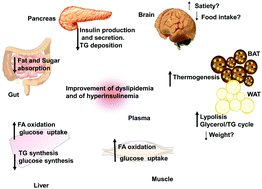Roles of proanthocyanidin rich extracts in obesity
Abstract
Obesity is a multifactorial disorder involving an abnormal or excessive amount of body fat. Obese people have a very high probability of developing metabolic syndrome, a condition in which cholesterol, lipid, and glucose levels rise, causing diabetes and heart disease. From the point of view of energy balance, the main contributors to obesity are excessive energy intake, inadequate energy expenditure and metabolic malfunctions. For this reason, health organisations are working to implement policies and plans to promote healthy eating and active living. However, these measures have not yet proven sufficient to combat this worldwide epidemic; therefore, drugs and bioactive compounds are being investigated to complement the existing strategies. In the present review, we discuss the available data regarding the modulation of obesity by proanthocyanidin rich extracts. Because studies with human subjects are very scarce, we focus on studies using laboratory animals. The results of in vitro studies are included because, although they cannot be directly extrapolated to the biological effects of proanthocyanidin, they can reveal some mechanisms of action.


 Please wait while we load your content...
Please wait while we load your content...